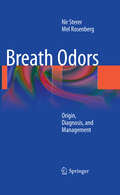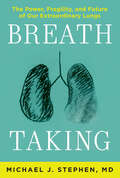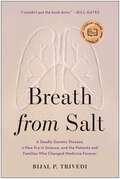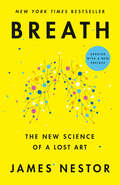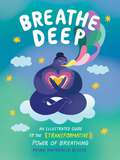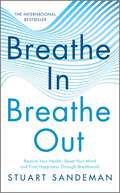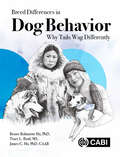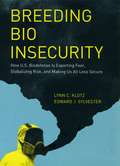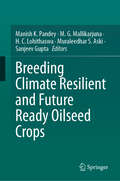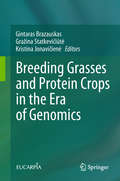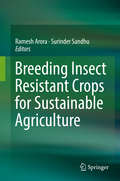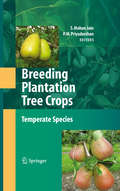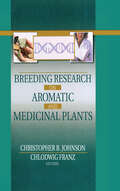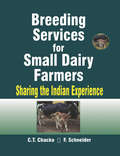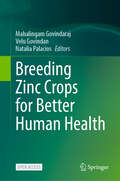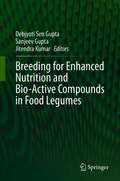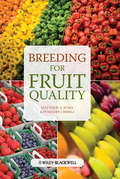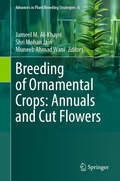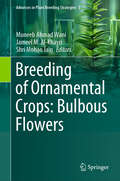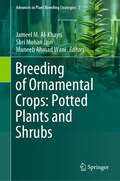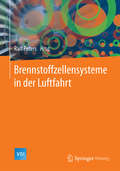- Table View
- List View
Breath Odors: Origin, Diagnosis, and Management
by Mel Rosenberg Nir StererBad breath is a common and embarrassing problem that everyone worries about, yet most health professionals still know little about its origins, diagnosis, and treatment. Over the past fifteen years, investigators have studied how bad breath is caused, where the odors originate, and which bacteria and gases are involved. Novel in vitro systems and measurement techniques have been proposed, and clinical studies conducted to compare new and traditional treatments. This illustrated text presents, for the first time, a comprehensive and cohesive science-based approach to bad breath, combining basic research with clinical approaches to diagnosis and treatment. All aspects of the subject are examined thoroughly and critically, including the psychological impact of breath odor and future prospects. The authors draw upon more than thirty years' combined experience in this field, both in the laboratory and as consultants to thousands of patients in Canada, the US, the UK, and elsewhere.
Breath Taking: The Power, Fragility, and Future of Our Extraordinary Lungs
by Michael J. StephenAn expert in pulmonary medicine shares a wide-ranging exploration of the human lung: the organ that explains our origins and holds the keys to our future.We take an average of 7.5 million breaths a year and some 600 million in our lifetime, and what goes on in our body each time oxygen is taken in and carbon dioxide expelled is nothing short of miraculous. “Our lungs are the lynchpin between our bodies and the outside world,” writes pulmonologist Michael Stephen. And yet, we too often take our lungs for granted.In Breath Taking, Stephen sheds much-needed light on our extraordinary lungs. He relates the history of oxygen on Earth and the evolutionary origins of breathing, and explores the healing power of breath and its spiritual potential. Stephen interweaves his narrative with scientific history, such as the development of the lung transplant, and poignant human stories, including his own frantic attempts to engage his son’s lungs at birth.Despite great advances in science, our lungs are ever more threatened. Asthma is on the rise, increasing anxiety leaves us vulnerable to disease, and COVID-19 has revealed that vulnerability in historic ways. Breath Taking offers inspiration and hope, inspiration, and vital perspective to us all.
Breath from Salt: A Deadly Genetic Disease, a New Era in Science, and the Patients and Families Who Changed Medicine Forever
by Bijal P. TrivediRecommended by Bill Gates and included in GatesNotes "Elaborating on the science as well as the business behind the fight against cystic fibrosis, Trivedi captures the emotions of the families, doctors, and scientists involved in the clinical trials and their 'weeping with joy' as new drugs are approved, and shows how cystic fibrosis, once a 'death sentence,' became, for many, a manageable condition. This is a rewarding and challenging work." —Publishers Weekly Cystic fibrosis was once a mysterious disease that killed infants and children. Now it could be the key to healing millions with genetic diseases of every type—from Alzheimer's and Parkinson's to diabetes and sickle cell anemia. In 1974, Joey O'Donnell was born with strange symptoms. His insatiable appetite, incessant vomiting, and a relentless cough—which shook his tiny, fragile body and made it difficult to draw breath—confounded doctors and caused his parents agonizing, sleepless nights. After six sickly months, his salty skin provided the critical clue: he was one of thousands of Americans with cystic fibrosis, an inherited lung disorder that would most likely kill him before his first birthday. The gene and mutation responsible for CF were found in 1989—discoveries that promised to lead to a cure for kids like Joey. But treatments unexpectedly failed and CF was deemed incurable. It was only after the Cystic Fibrosis Foundation, a grassroots organization founded by parents, formed an unprecedented partnership with a fledgling biotech company that transformative leaps in drug development were harnessed to produce groundbreaking new treatments: pills that could fix the crippled protein at the root of this deadly disease. From science writer Bijal P. Trivedi, Breath from Salt chronicles the riveting saga of cystic fibrosis, from its ancient origins to its identification in the dank autopsy room of a hospital basement, and from the CF gene's celebrated status as one of the first human disease genes ever discovered to the groundbreaking targeted genetic therapies that now promise to cure it. Told from the perspectives of the patients, families, physicians, scientists, and philanthropists fighting on the front lines, Breath from Salt is a remarkable story of unlikely scientific and medical firsts, of setbacks and successes, and of people who refused to give up hope—and a fascinating peek into the future of genetics and medicine.
Breath: The New Science of a Lost Art
by James NestorNo matter what you eat, how much you exercise, how skinny or young or wise you are, none of it matters if you&’re not breathing properly.There is nothing more essential to our health and well-being than breathing: take air in, let it out, repeat 25,000 times a day. Yet, as a species, humans have lost the ability to breathe correctly, with grave consequences. Journalist James Nestor travels the world to figure out what went wrong and how to fix it. The answers aren&’t found in pulmonology labs, as we might expect, but in the muddy digs of ancient burial sites, secret Soviet facilities, New Jersey choir schools, and the smoggy streets of São Paulo. Nestor tracks down men and women exploring the hidden science behind ancient breathing practices like Pranayama, Sudarshan Kriya, and Tummo and teams up with pulmonary tinkerers to scientifically test long-held beliefs about how we breathe. Modern research is showing us that making even slight adjustments to the way we inhale and exhale can jump-start athletic performance; rejuvenate internal organs; halt snoring, asthma, and autoimmune disease; and even straighten scoliotic spines. None of this should be possible, and yet it is. Drawing on thousands of years of medical texts and recent cutting-edge studies in pulmonology, psychology, biochemistry, and human physiology, Breath turns the conventional wisdom of what we thought we knew about our most basic biological function on its head. You will never breathe the same again.
Breathe
by Sarah CrossanInhale. Exhale. Breathe. Breathe. Breathe . . . The world is dead. The survivors live under the protection of Breathe, the corporation that found a way to manufacture oxygen-rich air. Alina has been stealing for a long time. She's a little jittery, but not terrified. All she knows is that she's never been caught before. If she's careful, it'll be easy. If she's careful. Quinn should be worried about Alina and a bit afraid for himself, too, but even though this is dangerous, it's also the most interesting thing to happen to him in ages. It isn't every day that the girl of your dreams asks you to rescue her. Bea wants to tell him that none of this is fair; they'd planned a trip together, the two of them, and she'd hoped he'd discover her out here, not another girl. And as they walk into the Outlands with two days' worth of oxygen in their tanks, everything they believe will be shattered. Will they be able to make it back? Will they want to?
Breathe Deep: An Illustrated Guide to the Transformative Power of Breathing
by Misha Maynerick BlaiseTake a deep breath and get lost in this illustrated guide to the transformative power of breathing combining inspiration, instruction, and amazing illustrations to create a one-of-a-kind book about the popular practice of breath work.Breathing happens. All day long you are sustained by the movement of air in and out of your lungs. Because it&’s a natural function most people don&’t give much thought to it. But when you consciously engage your breath, incredible things can happen. Filled with vibrant art, meaningful quotes, practical exercises, and lighthearted humor, Breathe Deep stokes the curious mind and inspires a deeper relationship with the power of breath. Drawing upon both ancient wisdom and cutting-edge science, Breathe Deep delves into the mechanics of respiration and the proven physical and emotional benefits of conscious breathing. As a bridge that unites body and mind, breath work is a powerful tool that can be used to calm anxiety and transform limiting mindsets.
Breathe In, Breathe Out: Restore Your Health, Reset Your Mind and Find Happiness Through Breathwork
by Stuart SandemanTHE INTERNATIONAL BESTSELLERIt&’s time to get your breath back.Since tragic loss brought him to breathwork, Stuart Sandeman has helped thousands of people transform their lives, simply by changing the way they breathe.In Breathe In, Breathe Out, Stuart takes you on a journey to discover a hidden power within you that can change the way you think and feel. His accessible exercises, grounded in research and developed over years of practice, will help you to: Sleep soundly and manage stress and pain. Identify and let go of the beliefs that are holding you back. Develop better focus and boost your performance in any field. Deepen the connection with yourself, others and the world around you.You can become stronger, healthier and happier than you've ever imagined. All you have to do is Breathe In, Breathe Out.
Breathless: The Scientific Race to Defeat a Deadly Virus
by David QuammenNational Book Award finalist Breathless tells the story of the worldwide scientific race to decipher the coronavirus SARS-CoV-2, trace its source, and make possible the vaccines to fight the Covid-19 pandemic—a &“luminous, passionate account of the defining crisis of our time&” (The New York Times).Breathless is a &“gripping&” (The Atlantic) but &“clear-eyed analysis&” (Time) of SARs-CoV-2 and its fierce journey through the human population, as seen by the scientists who study its origin, its ever-changing nature, and its capacity to kill us. David Quammen expertly shows how strange new viruses emerge from animals into humans as we disrupt wild ecosystems and how those viruses adapt to their human hosts, sometimes causing global catastrophe. He explains why this coronavirus will probably be a &“forever virus,&” destined to circulate among humans and bedevil us endlessly, in one variant form or another. As scientists labor to catch it, comprehend it, and control it, with their high-tech tools and methods, the virus finds ways of escape. Based on interviews with nearly one hundred scientists, including leading virologists in China and around the world, Quammen explains that: -Infectious disease experts saw this pandemic coming -Some scientists, for more than two decades, warned that &“the next big one&” would be caused by a changeable new virus—very possibly a coronavirus—but such warnings were ignored for political or economic reasons -The precise origins of this virus may not be known for years, but some clues are compelling, and some suppositions can be dismissed -And much more Written by &“one of our finest explainers of the natural world for decades&” (Chicago Tribune), This &“compelling and terrifying&” (The New York Times) account is an unparalleled look inside the frantic international race to understand and control SARS-CoV-2—and what it might mean for the next potential global health crisis.
Breed Differences in Dog Behavior: Why Tails Wag Differently
by Dr Renee R. Ha Tracy L. Brad Dr James C. HaHumans have bred dogs for physical and behavioral characteristics for millennia. These efforts can have unintended side effects, however, which may be either advantageous or cause issues - such as a predisposition to certain medical complaints, or, controversially, behavioural issues. The scientific study of domestic dogs is still in its infancy, but public demand for this information is at a record high as more and more pet owners seek to understand their canine family members. Focusing on the behavioral differences and tendencies that have arisen in different breed lines, this book explores, summarizes, and explains the scientific evidence on what breed can tell us about behaviour - and, crucially, what it cannot. This book covers: - the impact of inbreeding, how it contributes to problematic behavioral issues such as anxiety and aggression, and how it potentially affects the future health of the breed; - the limits of predicting a dog's behavior based upon breed, individual differences within breeds, and thus the corresponding limitations of breed-specific legislation; - guidance for professionals to help their clients better understand behavioral issues, traits, and appropriate expectations around the right breed for their household. Providing a comprehensive and approachable view of the science behind breed-specific behaviors, this book gives dog enthusiasts from all professional and personal backgrounds a better understanding of why dogs do what they do, and how we can improve our relationships with our canine companions. Covering genetics, phylogeny of canids, temperament, aggression, social behavior, and the history of dog breeding, it is an important read for researchers, students, veterinary practitioners and animal behaviourists, as well as shelter staff, dog trainers, or anyone looking for a greater understanding of dog breed differences.
Breeding Bio Insecurity: How U. S. Biodefense Is Exporting Fear, Globalizing Risk, and Making Us All Less Secure
by Lynn C. Klotz Edward J. SylvesterForceful and provocative, Breeding Bio Insecurity contends that U.S. bio defense policies generate more risk than the threat they are supposed to be addressing. By carefully spelling out their rationales, the book's authors place the burden of justification on the defenders of massive bio defense budgets. Replete with deft arguments and imaginative scenarios, this book should be read by scientists, policy makers and, indeed, all concerned citizens.
Breeding Climate Resilient and Future Ready Oilseed Crops
by Sanjeev Gupta Manish K. Pandey M. G. Mallikarjuna H. C. Lohithaswa Muraleedhar S. AskiThis edited book covers the application of modern genomics tools for developing climate-smart oilseed cultivars. The book's prime focus is on utilizing available oilseed genomic resources and application of next-generation genetics and breeding tools, viz. genome-wise association mapping, genomic selection, genome editing and accelerated breeding pipelines and their efficacy for rapid development and delivery of stress-resilient oilseeds cultivars. Oilseeds are crucial for human and animal nutrition and cater to diverse industrial applications. Besides oil content, the oilseed meal possesses proteins and a higher proportion of essential amino acids, which benefit human well-being. Additionally, the contribution of oilseeds towards renewable energy mitigates the risk of climate change by reducing carbon footprint. Hence, it is imperative to enhance oilseeds production from the current 178 to 282 million tons by 2050 to meet the demands of both the population and the environment. The current genomics era delivered various genomic resources in oilseed crops, which resulted in the discovery of genes for several agronomic and stress-resilience traits and resistance to pests and diseases. Further, the availability of next-generation plant breeding tools, such as genomic selection, genome editing, and speed breeding, are being implemented along with traditional and marked assisted selection. Thus, the book is framed to compile the importance and utility of next-generation breeding tools for enhancing stress resilience in oilseed crops in the climate change era. The book is exciting and valuable to national and international agricultural scientists, scholars and graduate students associated with oilseed crops improvement in specific and field crops in generic. The book also serves as reference in formulating various oilseed improvement programs for policymakers and research grant managers.
Breeding Climate Resilient and Future Ready Pulse Crops
by Sanjeev Gupta Manish K. Pandey M. G. Mallikarjuna H. C. Lohithaswa Muraleedhar S. AskiThis edited volume covers the application of modern breeding tools for developing climate-smart pulse crop cultivars. The primary focus is on utilizing available genomic resources and next-generation breeding technologies such as genome-wide association mapping, genomic selection, genome editing, and accelerated breeding pipelines for the rapid development of stress-resilient, systems-specific pulse cultivars. Pulses contribute to 10% of global daily protein intake and 5% of energy. Their ability to fix atmospheric nitrogen and serve as an alternative protein source to meat makes them crucial in combating global warming. With the global population expected to reach 9.8 billion by 2050, pulses production needs to increase by at least 70% to meet demand. However, pulses production is facing growing biotic and abiotic challenges, exacerbated by climate change. Thus, developing next-generation climate-smart cultivars is essential to ensure food and nutritional security. Recent efforts by global and national breeding communities have led to the discovery of new genomic resources, shifting breeding from phenotype-based to genome-based approaches. These advances integrate rapid generation advancement pipelines with genomic-assisted breeding, trait mapping, and genome editing tools. This book is valuable for agricultural scientists, scholars, and graduate students involved in pulse crop improvement. It also serves as a reference for policymakers and research grant managers in formulating pulse research programs.
Breeding Grasses and Protein Crops in the Era of Genomics
by Gintaras Brazauskas Gražina Statkevičiūtė Kristina JonavičienėThis book includes papers presented at the 2017 Joint meeting of Fodder Crops and Amenity Grasses Section and Protein Crops Working Group of EUCARPIA-Oil and Protein Crops Section. The theme of the meeting “Breeding Grasses and Protein Crops in the Era of Genomics” has been divided into six parts: (1) Utilisation of genetic resources and pre-breeding, (2) Genetic improvement of quality and agronomic traits, (3) Breeding for enhanced stress tolerance (4) Implementation of phenomics and biometrics, (5) Development of genomic tools and bioinformatics and (6) Reports of Parallel Sessions.
Breeding Insect Resistant Crops for Sustainable Agriculture
by Ramesh Arora Surinder SandhuThis book reviews and synthesizes the recent advances in exploiting host plant resistance to insects, highlighting the role of molecular techniques in breeding insect resistant crops. It also provides an overview of the fascinating field of insect-plant relationships, which is fundamental to the study of host-plant resistance to insects. Further, it discusses the conventional and molecular techniques utilized/useful in breeding for resistance to insect-pests including back-cross breeding, modified population improvement methods for insect resistance, marker-assisted backcrossing to expedite the breeding process, identification and validation of new insect-resistance genes and their potential for utilization, genomics, metabolomics, transgenesis and RNAi. Lastly, it analyzes the successes, limitations and prospects for the development of insect-resistant cultivars of rice, maize, sorghum and millet, cotton, rapeseed, legumes and fruit crops, and highlights strategies for management of insect biotypes that limit the success and durability of insect-resistant cultivators in the field. Arthropod pests act as major constraints in the agro-ecosystem. It has been estimated that arthropod pests may be destroying around one-fifth of the global agricultural production/potential production every year. Further, the losses are considerably higher in the developing tropics of Asia and Africa, which are already battling severe food shortage. Integrated pest management (IPM) has emerged as the dominant paradigm for minimizing damage by the insects and non-insect pests over the last 50 years. Pest resistant cultivars represent one of the most environmentally benign, economically viable and ecologically sustainable options for utilization in IPM programs. Hundreds of insect-resistant cultivars of rice, wheat, maize, sorghum, cotton, sugarcane and other crops have been developed worldwide and are extensively grown for increasing and/or stabilizing crop productivity. The annual economic value of arthropod resistance genes developed in global agriculture has been estimated to be greater than US$ 2 billion Despite the impressive achievements and even greater potential in minimizing pest- related losses, only a handful of books have been published on the topic of host-plant resistance to insects. This book fills this wide gap in the literature on breeding insect- resistant crops. It is aimed at plant breeders, entomologists, plant biotechnologists and IPM experts, as well as those working on sustainable agriculture and food security.
Breeding Plantation Tree Crops: Temperate Species
by P. M. Priyadarshan Shri Mohan JainTree species are indispensable to human needs. Due to their long life cycle and environmental sensitivity, breeding trees for sustainable production is a formidable challenge in order to meet the demands of growing human population and industries. Fruit crops such as apple, cocoa, mango, citrus, litchi, pear, dates, and coconut or industrial crops including rubber and tea, improving yield under the optimal, sub-optimal and marginal areas call for a unified worldwide effort. While the uniqueness of coconut as 'kalpavriksha' (Sanskrit - meaning tree of life) makes its presence in every continent from Far East to South America, tree crops such as cocoa, oil palm, rubber, apple, peach and walnut prove their environmental sensitivity towards tropical, subtropical and temperate climates. Date palm is quintessential for desert climate. Thus, from soft drinks to breweries to oil to tires, the value addition offers a spectrum of products to human kind, enriched with nutritional, environmental, financial, and trade related attributes. This volume is a compilation of information on breeding of temperate tree species and provides first hand comprehensive knowledge to research, teach, and make policies.
Breeding Research on Aromatic and Medicinal Plants
by Christopher B Johnson Chlodwig FranzThe field of medicinal/aromatic plant breeding is growing and changing?this resource will help you stay up to date! In this essential book, researchers from large and small laboratories and institutions throughout Europe and the Mediterranean region explore recent developments in the selection and breeding of aromatic and medicinal plants. They take varied approaches?from traditional breeding to the use of molecular markers?and complement them with up-to-date information on biodiversity and resource conservation. From the editors: ?It is widely recognized that a strategy of `conservation through use,? by which plant collection via wild harvesting is replaced by controlled cultivation, is the best way forward if we are to balance human demands with the necessary conservation of the biodiversity represented by these species. That provides one major driving force for research in this field. Another concerns the very real need for improving the quality control of products on the market, both to satisfy consumer demand and to conform with the (justifiably) increasing requirements for standardization and precise identification of the composition of the plant materials being sold for human use. We hope that this volume will give readers a taste of the exciting developments in the field.? Breeding Research on Aromatic and Medicinal Plants examines: breeding for resistance and abiotic factors manipulating natural product accumulation through genetic engineering biochemical and molecular regulation of essential oil accumulation economic and legal considerations that breeders will encounter the ethical aspects of breeding these plants
Breeding Services for Small Dairy Farmers: Sharing the Indian Experience
by C T ChackoBetter validation of indigenous domestic animal genetic resources is becoming more important with regard to the potential of livestock for poverty alleviation and income generation. To improve indigenous breeds for sustainable income and employment generation, the methods to be employed are the same as developed in systematic breeding programs, be it for cross-breeding or selective breeding within a specific breed. This book systematically introduces the reader to the breed improvement theory and illustrates the theory with practical examples and case studies. The book is addressed to animal science teachers, to undergraduate and postgraduate students as well as to decision makers in the state and central livestock departments.
Breeding Zinc Crops for Better Human Health
by Mahalingam Govindaraj Velu Govindan Natalia PalaciosThis open access book discusses Micronutrient Malnutrition (MM) is a major obstacle to the development of human resources in developing nations in Asia and Africa and has been identified as a public health concern. Globally, more than 2 billion people suffer from MM. The most susceptible groups are women and young children under five. The main cause of the persistence of MM prevalence is the inaccessibility, unavailability, or high cost of diets rich in zinc. Typically, staple foods are poor in minerals. An inadequate intake of zinc (Zn) compromises human nutrition and immunological function. Breeding staple crops with enhanced critical nutrients offers a long-term solution for populations dependent on single staples or diets with less diversity. The significance of zinc in human nutrition, high throughput zinc phenotyping techniques, breeding product profile design, new varieties and germplasm that are rich in zinc, and the genetics and genomics of zinc are all covered in this book. For the first time, the publicly available standards (PAS) under the BSI standards for zinc crops were reviewed with an eye toward future global commercial production and commercialization. This edited volume will function as a scientific knowledge base and reference for researchers, graduate students, and other professionals in a comparable field. The goal is to enable biofortification science to help the poor world achieve food and nutrition security.
Breeding for Enhanced Nutrition and Bio-Active Compounds in Food Legumes
by Sanjeev Gupta Jitendra Kumar Debjyoti Sen GuptaMore than 20 million childhood deaths occur every year due to the micronutrient deficiency and diet-related non-communicable diseases (cardiovascular diseases, cancers, chronic respiratory diseases and diabetes). The United Nations (UN) recently announced that the increase in chronic, non-communicable diseases has resulted in 36 million deaths around the world annually, claiming more lives than all other causes combined. These chronic diseases are not isolated to developed countries and are even more pronounced in the developing world. Such chronic illnesses have caused far more deaths than infectious diseases throughout the world (except Africa) in recent years. Therefore, enrichment of micronutrients in staple food crops is of paramount importance for the nutritional security in our world. Biofortification is the development of micronutrient- and/or vitamin-rich crops using traditional crop improvement practices as well as modern biotechnology tools. It is a more sustainable and cost effective method than food supplementation, fortification and diet diversification. This work consolidates available information on the different aspects of breeding for improved nutrition of pulses. An overview of entire pulses based on their nutritional profile is given so that audience can find the desired information easily. Food legumes are the active ingredients in many gluten-free food products and there is a continuous rise of the use of pulses flour in milling and baking processes. Our book sheds light on recent efforts and the underlying constraints of meeting the public demand. We believe this work provides the basic information for anyone interested in biofortification and stimulate further research to meet this unique challenge.
Breeding for Fruit Quality
by Matthew A. Jenks Penelope J. BebeliThe global demand for high quality fruits that are rich in nutrients and that can endure the demands of worldwide supply chains is growing rapidly. Fruits are an important component of the human diet, providing vitamins, minerals, antioxidants, and fiber. All of these qualities contribute to the nutritional needs and health maintenance of humans. Breeding for Fruit Quality reviews the application of modern plant breeding methods to the development of improved varieties of fruits. Breeding for Fruit Quality opens with chapters that look at fruit biology and breeding strategies behind specific traits, including a look at traits such as organoleptic quality, nutritional value, and improved yield, among others. Subsequent chapters review breeding efforts to improve overall quality in a wide range of specific fruits. Providing broad ranging coverage of cutting edge methods now being applied to the development of fruit crops, Breeding for Fruit Quality will be a valuable resource for fruit biologists, breeders, geneticists, and industry personnel. Key Features: Broad coverage of modern breeding technologies being implemented to improve overall fruit quality Trait specific chapters explore efforts to promote traits of industrial and nutritional importance Chapters in fruits, ranging from apple and grapes to tomatoes and olives, provide detailed coverage of breeding practices for economically important fruit crops
Breeding of Ornamental Crops: Annuals and Cut Flowers (Advances in Plant Breeding Strategies #6)
by Shri Mohan Jain Jameel M. Al-Khayri Muneeb Ahmad WaniFlowers and other ornamental plants are used for all occasions to meet consumers demands preferably novel flowers traits, e.g., fragrance, flower color and shape, early flowering, less water consumption, long shelf-life. The worldwide floricultural industry is worth over 50 billion Euros and can serve as a ‘food security’, socio-economic impact, and generate employment. Ornamental industry is regarded as one of the fastest growing farm industries. This industry is sustained through novelty, thus there is increasing demand on plant breeders in both public and private sectors to fulfil consumer’s needs. Biotechnological approaches such as genetic transformation, genomics, nanotechnology, and gene editing are well suited for designing custom-made novel traits of flowers benefiting both ornamental and cosmetic industry. Moreover, micropropagation is well exploited commercially for large-scale plant production along with vertical and digital farming, and artificial intelligence especially by the floriculture industry. This book focuses on advances in breeding strategies of diverse range of ornamental plants. It consists of 2 parts, Part I Flowering annuals and Part II Cut flowers. Each chapter, contributed by eminent authors, is devoted to an individual ornamental species or a group of related species. It provides an in depth understanding of modern breeding strategies including traditional methods and biotechnological approaches. Topics covered in each chapter, in relation to the subject species, include current cultivation practices and challenges, germplasm biodiversity and conservation, traditional breeding, molecular breeding, tissue culture applications, genetic engineering and gene editing, mutation breeding, hybridization, and future research directions. Major concepts are illustrated with color photos.
Breeding of Ornamental Crops: Bulbous Flowers (Advances in Plant Breeding Strategies #5)
by Shri Mohan Jain Jameel M. Al-Khayri Muneeb Ahmad WaniFlowers and other ornamental plants are used for all social occasions. Consumers' preferences dictate the development of novel flower traits such as fragrance, flower color and shape, early flowering, less water consumption, and long shelf-life. The worldwide floricultural industry is worth over 50 billion Euros and can serve as a component of food security, influence socio-economic development, and generate employment. The ornamental industry is regarded as one of the fastest-growing farm industries. This industry is sustained through novelty, thus there is an increasing demand for plant breeders in both public and private sectors to fulfill consumers’ needs. Biotechnological approaches such as genetic transformation, genomics, nanobiotechnology, and gene editing are well suited for designing custom-made novel traits of flowers benefiting both the ornamental and cosmetic industries. Moreover, micropropagation is well exploited commercially for large-scale plant production along with vertical and digital farming, and artificial intelligence, especially by the floriculture industry. This book focuses on advances in breeding strategies of bulbous flower ornamental plants. Each chapter, contributed by eminent authors, is devoted to an individual ornamental species or a group of related species. It provides an in-depth understanding of modern breeding strategies including traditional methods and biotechnological approaches. Topics covered in each chapter, in relation to the subject species, include current cultivation practices and challenges, germplasm biodiversity and conservation, traditional breeding, molecular breeding, tissue culture applications, genetic engineering and gene editing, mutation breeding, hybridization, and future research directions. Major concepts are illustrated with color photos.
Breeding of Ornamental Crops: Potted Plants and Shrubs (Advances in Plant Breeding Strategies #7)
by Shri Mohan Jain Jameel M. Al-Khayri Muneeb Ahmad WaniFlowers and other ornamental plants are used for all occasions to meet consumers demands preferably novel flowers traits, e.g., fragrance, flower color and shape, early flowering, less water consumption, long shelf-life. The worldwide floricultural industry is worth over 50 billion Euros and can serve as a ‘food security’, socio-economic impact, and generate employment. Ornamental industry is regarded as one of the fastest growing farm industries. This industry is sustained through novelty, thus there is increasing demand on plant breeders in both public and private sectors to fulfil consumer’s needs. Biotechnological approaches such as genetic transformation, genomics, nanotechnology, and gene editing are well suited for designing custom-made novel traits of flowers benefiting both ornamental and cosmetic industry. Moreover, micropropagation is well exploited commercially for large-scale plant production along with vertical and digital farming, and artificial intelligence especially by the floriculture industry. This book focuses on advances in breeding strategies of diverse range of ornamental plants. It is composed of 2 parts, Part I Ornamental potted plants, and Part II Ornamental shrubs. Each chapter, contributed by eminent authors, is devoted to an individual ornamental species or a group of related species. It provides an in depth understanding of modern breeding strategies including traditional methods and biotechnological approaches. Topics covered in each chapter, in relation to the subject species, include current cultivation practices and challenges, germplasm biodiversity and conservation, traditional breeding, molecular breeding, tissue culture applications, genetic engineering and gene editing, mutation breeding, hybridization, and future research directions. Major concepts are illustrated with color photos.
Breeding strategies for sustainable forage and turf grass improvement
by Dan Milbourne Susanne BarthFrom the 4th - 8th of September 2011, the Eucarpia Fodder Crops and Amenity Grasses Section, held its 29th Meeting in the surroundings of Dublin Castle in Ireland. The theme of the meeting was 'Breeding strategies for sustainable forage and turf grass improvement'. Grasslands cover a significant proportion of the land mass of the world, and play a pivotal role in global food production. At the same time we are faced with several challenges that affect the way in which we think about this valuable set of resources. The population of the world is expected to exceed 9 billion by 2050, and increase of about one third relative to today's levels. This population increase will be focused in urban areas, and in what are currently viewed as "developing" countries, meaning that the buying power of this increased population will be greater - shifting the balance of demand from staple crops to high value items such as meat and dairy products. Overall that the world will have to approximately double agricultural output across all categories of food to meet the demands of this larger, urbanised population. This is occurring against a backdrop of equally large challenges in terms of global climate change. Agriculture is already a significant contributor to e.g. greenhouse gas emissions, deforestation and soil erosion. The situation is made more complex by an increased emphasis on biofuels as a solution for our imminent oil shortage, resulting in increased competition between land utilised for food and fuel. In short, agriculture must continue to feed the world, whilst not contributing to damaging it further. It must be sustainable. Plant breeding plays a significant but frequently understated role in meeting the challenges presented by this complex and changing scenario. However, plant breeding and improvement is itself undergoing radical change driven by technology. This book explores how forage and turf breeding is changing and adapting to meet these challenges using the technological advances being experienced in plant breeding as a whole.
Brennstoffzellensysteme in der Luftfahrt (VDI-Buch)
by Ralf PetersDer Einsatz von Brennstoffzellensystemen im Flugzeug bietet die M#65533;glichkeit, die Funktionen Strom, Wasser- und Inertgaserzeugung mit Hilfe eines einzigen Systems zu gew#65533;hrleisten, Hilfssysteme (Wassertanks, die konventionelle APU und das FTIS) k#65533;nnen ebenso entfallen wie die zus#65533;tzliche Speicherung von Wasser. Generatoren und Batterien k#65533;nnen kleiner dimensioniert werden. Diese Ma#65533;nahmen verringern den Kraftstoffverbrauch, erh#65533;hen die Gesamteffizienz eines Flugzeuges und erm#65533;glichen einen emissionsarmen Betrieb von Flugzeugen im Flug und besonders am Boden. Die Autoren vergleichen Aspekte bei der Nutzung heutiger und zuk#65533;nftiger Kraftstoffe f#65533;r Brennstoffzellen in der Luftfahrt. Die Eigenschaften geeigneter Brennstoffzellentypen werden beschrieben und analysiert, es wird dabei dargestellt warum der Brennstoffzellentyp HT-PEFC besonders geeignet ist und welche Herausforderungen damit verbunden sind. Technische Entwicklungen, wie die HT-PEFC Stackentwicklung, die der Komponenten des Brenngaserzeugungssystems und der Aufbau und der Test eines 5 kWe HT-PEFC Gesamtsystems werden beschrieben. Das Buch schlie#65533;t mit der Betrachtung von Brennstoffzellensystemen als Bestandteil eines multifunktionalen Systems und dem Ausblick auf zuk#65533;nftige Anwendungen in der Luftfahrttechnik.
